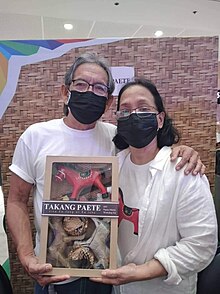
Taka (taká) refers to papier-mâché made using carved wooden sculpture used as a mold. The craft originated in the town of Paete, Laguna in the Philippines.
History
Taka was made by Paete local Maria Piday. During Christmas, Piday was in charge of the church's decorations. The wooden angels and cherub was heavy causing the carvings to fall. Piday devised the lightweight taka papier-mâché as an alternative to the wooden sculptures. Piday was also a maker of local toys such as the yoyo and the small acrobat hand puppet. Taka eventually became folk art and was sold to nearby towns for festivals. In the 1970s, Tere Afuang, a knowledgeable practitioner of the craft, popularized the craft.
Taka-making
A takaan, a carved wooden sculpture, is used as a mold in making taka. Brown craft paper is used as a final layer for taka made for export. This provides a thicker base and smoother finish for the craft. Taka is also painted. The traditional way of painting a taka is to use primary colors, add simple flower motifs and use repetitive lines and shapes. Gold finish, usually used in angel, reindeer and huge taka is accomplished by using gilded paper.
Subjects of Taka
Common and traditional subjects of taka include the manok, kabayo, kalabaw, dalaga (chicken, horse, carabao, maiden) which is made primarily for local use. Due to exposure and migration of Paete residents to Manila and abroad, European-influenced papier-mâché toys began to be made for export to other countries, such as Germany. Taka images now include those of Santa Claus, reindeer, giraffes, and other subjects that are in demand.

Do-it-yourself Taka Workshop Kit
In January 2022, a family from Paete curated and launched a do-it-yourself papier-mâché workshop kit, which contains everything that one needs to make a taka, including the molde (takaan), dyaryo, paste mix, a cutter knife, as-is, a paint set, and a step-by-step instruction guide.
Through the DIY taka kit, the family hopes to "preserve the knowledge of taká-making," and to "give people the opportunity to experience the taká-making process and get to relate with the who make them." The family also wishes to honor these local artisans through the kit.
In June 2022, the kit was recognized as the Most Innovative Product - Non-food (Second Place), during the Laguna OTOP Hybrid Expo 2022 hosted by the Department of Trade Industry - Laguna.
References
- ^ Datuin, Flaudette May; et al. (1997). "Paete:A Living Fusion of Art & Society". Art and Society. Diliman, Quezon City: University of the Philippines. pp. 240–241. ISBN 971-91907-01.
- Lago, Amanda (2022-02-05). "Hold your horses! How a do-it-yourself taká kit keeps Paete's papier-mâché art alive". RAPPLER. Retrieved 2024-04-02.